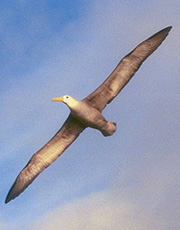Albatrosses at risk due to fishing
mongabay.com
October 3, 2006
|
|
About 1 percent of world’s waved albatrosses were killed by fishermen in a one-year period according to a new study published online Sept. 26 in the journal Biological Conservation.
“If that happens every year, that is not sustainable,” said Jill Awkerman, a Wake Forest University graduate student who is the lead author of the study. “In a matter of decades, you could be talking about extinction.”
Awkerman and David Anderson, professor of biology at Wake Forest, studied survival rates of waved albatrosses on Española Island in the Galapagos Islands by tagging 2,550 albatrosses with identification bands. A year later fishermen returned 23 dead albatrosses, suggesting a death rate of about one percent. Follow up surveys found that albatrosses often became tangled accidentally in submerged gillnets and fishermen, instead of freeing the birds, killed them as a source of food.
 A Galapagos waved albatross. Image courtesy of Wake Forest University. |
The researchers were especially troubled by the unequal sex distribution of captured birds — 82 percent of the dead birds were male. Awkerman said that fewer males in the population limit the number of breeding pairs — especially significant in a species with a low reproductive rate.
“Fishing mortality could be partially responsible for an apparent decline in the breeding population,” Awkerman said. “Our study puts together a frightening picture of what the potential for this species is. But, with educational outreach and further research there is potential to turn this around before too much damage is done.”
Awkerman noted that Ecuador and Peru appear to be taking steps to address the issue.
RELATED NEWS ARTICLES
All albatrosses dead in transoceanic race. All 18 albatross competitors died in the 2005 Big Bird Race. The annual 10,000-kilometer race, which which aims to raise international awareness about the dangers of longline fishing to the albatross and other marine species, began on May 2 from Tasmania, Australia. None of the endangered albatrosses tracked by satellites made it to the finish line in South Africa.
Free floating fishing nets kill marine mammals, turtles and sea birds. Thousands of miles from any human habitation, fishing nets hundreds of meters long and balls of net tens of meters across, lost or abandoned by their former owners but still an environmental hazard, foul huge swaths of the Pacific Ocean. However, the sheer mass of those so-called ghostnets floating freely in waves has come as an unpleasant surprise to NOAA scientists studying the phenomenon.
This article is based on a news release from Wake Forest University.
.